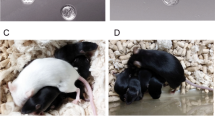Summary
-
1.
A simple and rapid method is described for the isolation and purification of oocyte vitellin ofLocusta migratoria. The isolated protein has been shown to be homogenous by polyacrylamide gel electrophoresis, isoelectric focusing, sedimentation analysis and in the Ouchterlony test.
-
2.
The yolk protein stains with Sudan black and lipid crimson, it reacts with the PAS-reagent and is thus a lipo-glycoprotein. Its isoelectric point is at pH 6.9. At neutral pH the protein is poorly soluble in solutions of low ionic strength, but is easily soluble at alkaline pH. At neutral or acidic pH the yolk protein tends to aggregate to a dimer and a trimer.
-
3.
The amino acid composition shows a high content of aspartic and glutamic acid or their amides and a low percentage of sulphur containing amino acids. As N-terminal amino acids alanine and aspartic acid are found.
-
4.
The yolk protein consists of several non-identical subunits. In polyacrylamide gel electrophoresis with sodium dodecyl sulphate subunits of 55,000, 65,000, 110,000, 120,000 and 130,000 Daltons are found. The molecular weight was determined to 530,000±30,000 Daltons, the sedimentation coefficient ass 20,w=16.3±0.02 (corrected). The frictional ratio isf/f 0=1.105, the molar extinction coefficient at 280 nm is 4.2×105 (=0.91 per mg protein).
All subunits stain as glycoproteins; the total sugar content was determined as 11%.
Similar content being viewed by others
References
Ames, B.N.: Assay of inorganic phosphate, total phosphate and phosphatases. In: Methods in enzymology, Vol. 8. Complex carbohydrates (Neufeld, E.F., Ginsburg, V., eds.), pp. 115–118. New York and London: Academic Press 1966
Anderson, L.M., Telfer, W.H.: Trypan blue inhibition of yolk deposition—a clue to follicle cell function in the cecropia moth. J. embryol. exp. Morph.23, 35–52 (1970)
Bar-Zev, A., Wajc, E., Cohen, E., Sapir, L., Applebaum, S. W., Emmerich, H.: Vitellogenin accumulation in the fact body and haemolymph ofLocusta migratoria in relation to egg maturation. J. Insect Physiol.21, 1257–1263 (1975)
Bentz, F., Girardie, A., Cazal, M.: Étude électrophorétique des variations de la protéinémie chezLocusta migratoria pendant la maturation sexuelle. J. Insect Physiol.16, 2257–2270 (1973)
Brookes, V.J.: The induction of yolk protein synthesis in the fat body of an insectLeucophaea maderae, by an analogue of the juvenile hormone. Develop. Biol.20, 459–471 (1969)
Catsimpoolas, N.: Micro-isoelectric focusing in polyacrylamide gel columns. Analyt. Biochem.26, 480–482 (1968)
Chen, T., Couble, P., De Lucca, F., Wyatt, G. R.: Juvenile hormone control of vitellogenin synthesis inLocusta migratoria. In: The juvenile hormones (L. J., Gilbert, ed.). New York and London: Plenum Press, in press 1976
Chino, H., Murakami, S., Harashima, K.: Diglyceride-carrying lipoproteins in insect haemolymph. Isolation, purification and properties. Biochim. biophys. Acta (Amst.)176, 1–26 (1969)
Cutting, J.A., Roth, T.F.: Staining of phosphoproteins on acrylamide gel electropherograms. Analyt. Biochem.54, 386–394 (1973)
Dejmal, R.K., Brookes, V.J.: Insect lipovitellin. Chemical and physical characteristics of a yolk protein from the ovaries ofLeucophaea maderae. J. biol. Chem.247, 869–874 (1972)
Doane, W.W.: Role of hormones in insect development. In: Developmental system: Insects, Vol. 2 (Counce, S.J., Waddington, C.H., eds.), pp. 291–497. New York and London Academic Press 1973
Emmerich, H., Hartmann, R.: A carrier lipoprotein for juvenile hormone in the haemolymph ofLocusta migratoria. J. Insect Physiol.17, 1663–1675 (1973)
Engelmann, E.: The physiology of insect reproduction. Oxford: Pergamon Press 1970
Engelmann, F., Friedel, T.: Insect yolk protein precursor, a juvenile hormone induced phosphoprotein. Life Sci.14, 587–594 (1974)
Hagedorn, H.H., Judson, C.L.: Purification and site of synthesis ofAedes aegypti yolk protein. J. exp. Zool.182, 367–378 (1972)
Koeppe, J., Ofengand, J.: Juvenile hormone induced vitellogenin synthesis inLeucophaea maderae from large precursor polypeptides. In: The juvenile hormones (L.J. Gilbert, ed.), New York and London: Plenum Press, in press 1976
Lowry, O.H.,Rosenbrough, N.J., Farr, A.L., Randall, R.J.: Protein measurement with the Folin phenol reagent. J. biol. Chem.193 265–275 (1951)
Maurer, H.R.: Disc electrophoresis and related techniques of polyacrylamide gel electrophoresis. Berlin and New York: De Gruyter 1971
Minks, A.K.: Biochemical aspects of juvenile hormone action in the adultLocusta migratoria. Archs. néerl. Zool.17, 175–258 (1967)
Mokrasch, L. C.: Analysis of hexophosphate and sugar mixtures with the anthrone reagent. J. biol. Chem.208, 55–59 (1954)
Mordue, W., Goldsworthy, G.J.: The physiological effects of corpus cardiacum extracts in locusts. Gen. comp. Endocrinol.12, 360–369 (1969)
Pan, M. L., Wallace, R.A.: Cecropia vitellogenin: Isolation and characterization. Amer. Zool.14, 1239–1242 (1974)
Peled, Y., Tietz, A.: Isolation and properties of a lipoprotein from the haemolymph of the locustLocusta migratoria. Insect Biochem.5, 61–72 (1975)
Roe, J.R.: The determination of sugar in blood and spinal fluid with anthrone reagent. J. biol. Chem.212, 335–343 (1955)
Schachman, H.K.: Ultracentrifugation in biochemistry. New York and London: Academic Press 1959
Schneider, R.: Protein-Analysen an einzelnen Eiern und Eiteilen während der Embryonalentwicklung vonAcheta domesticus L. Ph.D. thesis, Philipps University, Marburg (1973)
Stark, G.R., Smyth, D.G.: The use of cyanate for the determination of NH2-terminal residues in proteins. J. biol. Chem.238 214–226 (1963)
Telfer, W.H.: The selective accumulation of blood proteins by the oocytes of saturniid moths. Biol. Bull.118, 338–351 (1960)
Wallace, R.A.: Studies of amphibian yolk; IX. Xenopus vitellogenin. Biochim. biophys. Acta (Amst.)215, 176–183 (1970)
Wallace, R.A., Walker, S.L., Hauschka, P.V.: Crustacean lipovitellin. Isolation and characterization of the major high density lipoprotein from eggs of Decapoda. Biochemistry6, 1582–1590 (1967)
Yamasaki, K.: Characterization and partial purification of a mannan-like polysaccharide in the eggs ofLocusta migratoria. Insect Biochem.3, 79–90 (1973)
Yamasaki, K.: Yolk protein from eggs ofLocusta migratoria and glycopeptides from the protein. Insect Biochem.4, 411–422 (1974)
Author information
Authors and Affiliations
Rights and permissions
About this article
Cite this article
Gellissen, G., Wajc, E., Cohen, E. et al. Purification and properties of oocyte vitellin from the migratory locust. J Comp Physiol B 108, 287–301 (1976). https://doi.org/10.1007/BF00691677
Received:
Issue Date:
DOI: https://doi.org/10.1007/BF00691677




